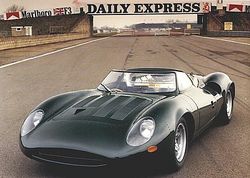.
Jaguar XJ13

| |
| Jaguar XJ13 | |
|---|---|
| Jaguar | |
| Production | 1966 1 produced |
| Class | Sports car |
| Body Style | Roadster |
| Length | 176.5 in (4483 mm) |
| Width | 73.0 in (1854 mm) |
| Height | 38.0 in (965 mm) |
| Wheelbase | 96.0 in (2438 mm) |
| Weight | 2,478 lb (1124 kg) |
| Transmission | five-speed manual |
| Engine | 5.0 L DOHC V12 |
| Power | 502 bhp @ 7,600 rpm 386 lb ft @ 6,300 rpm |
| Competition | Ford GT40 |
| Designer | Malcolm Sayer |
The XJ13 was a prototype racing car developed by Jaguar to challenge at Le Mans in the mid-1960s.
Development
Jaguar had considered the manufacture of a V12 engine as far back as 1955, initially for racing purposes, and then developing a road-going version, unlike the XK which was designed as a production engine and later pressed into service for racing. The engine design was essentially two XK 6-cylinder engines on a common crankshaft with an aluminium cylinder block, although there were differences in the inlet porting, valve angles and combustion chamber shape. The first engine ran in 1964.
The idea of a mid-engined prototype was first mooted in 1960, but it was not until 1965 that construction began, with the first car running by March 1966. The aluminium body was designed by Malcolm Sayer, the aerodynamicist responsible for the Jaguar C-type, D-type, E-type and XJS, who used his Bristol Aeroplane Company background to build it using techniques borrowed from the aircraft industry.
The XJ13 had mid-engine format with the 5.0 litre V12 engine mounted behind the driver, and a ZF Transaxle driving the rear wheels. Suspension was similar to that of the E-Type.
The development of the XJ13, although treated seriously by the designers, was never a priority for company management, and became less so following the 1966 merger with BMC. By that time Ford had developed the 7.0 litre GT40, and so the XJ13 was considered obsolete by the time the prototype was complete. The prototype was tested at MIRA and at Silverstone, which confirmed that it would have required considerable development to make it competitive. The prototype was put into storage and no further examples were made.
Launch of Series 3 E-Type
In 1971 the Series 3 E-type was about to be launched with Jaguar's first production V12 engine. The XJ13 was taken out of storage to be filmed at MIRA for the E-type publicity video. Unfortunately, a rear tyre burst at high speed during a final high-speed run, the car rolled heavily and was nearly destroyed. Jaguar test driver Norman Dewis was fortunately unharmed. The wreck of the car was put back into storage.
Some years later, the car was rebuilt, to a specification similar to the original, using the body jigs made for its original construction. The car is now displayed in the Jaguar Daimler Heritage Trust collection.
See also
Error creating thumbnail: Unable to save thumbnail to destination
| ||
| JAGUAR | ||
|
Tata Motors | Jaguar | Land Rover | Hispano Carrocera SA | Tata Daewoo Commercial Vehicle | Daewoo Bus Current Models: XF (R) · XJ (R) · XK (R) Historic Models: X-Type · E-Type · XJS · XKSS · XK120 · XK140 · XK150 · XJ220 · 240 · 340 · Mk. VII · Mk. VIII · Mk. IX · Mk. X · Mk. V · Mk. IV · Mark 2 · Mark 1 · 3.5 Litre · 2.5 Litre · 1.5 Litre · S-Type (1963-1968) · 420 · S-Type · SS100 · XJR-15 Concept Cars: C-XF · R-Coupe · RD-6 · Fuore XF 10 · Pirana Concept · XK180 Concept · F-Type Concept · XK-RR Concept · XK-RS Concept · Concept Eight · XJ Limo Green Hybrid Study Concept · XJ75 Platinum Concept · C-X75 Concept One-Offs: XJ13 Racing Vehicles: C-Type · D-Type · XJR-5 · XJR-6 · XJR-7 · XJR-8 · XJR-9 · XJR-10 · XJR-11 · XJR-12 · XJR-14 · XJR-16 · XJR-17 · XJ-S · R1 · R2 · R3 · R4 · R5 · XKR GT3 · XKR GT2 · RSR XKR GT | ||
| Sir William Lyons | Corporate website | A brand of the Tata Group |
